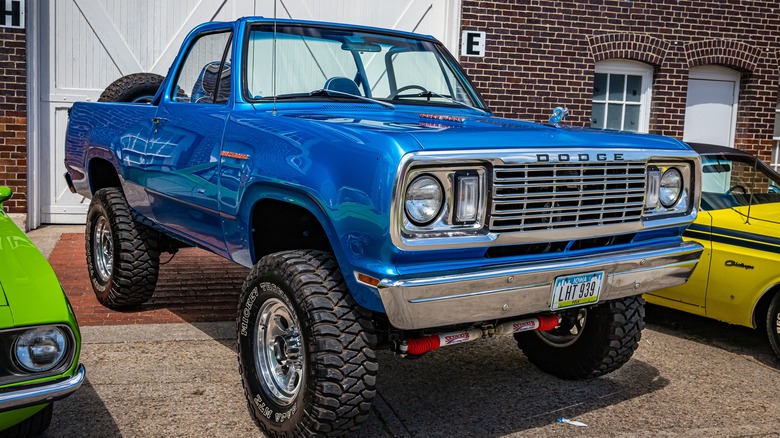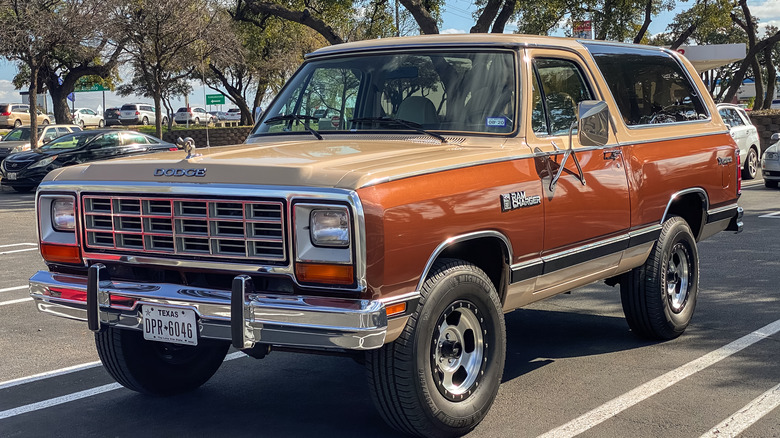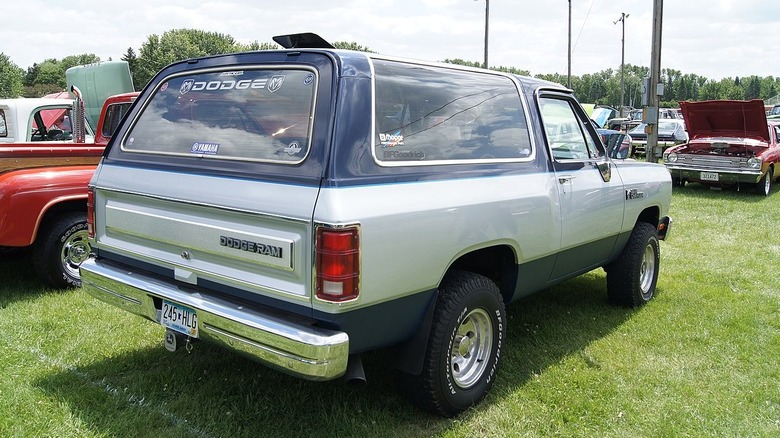Why Dodge Discontinued The Ramcharger, Its First SUV
Just about everyone is familiar with Ford's long-running second-generation Bronco — most famously, a white Bronco that was driven in a low-speed police chase in 1994 with O.J. Simpson as a passenger. Nowadays, a modern interpretation is a wildly popular off-road alternative to the Jeep Wrangler.
Chevy's Blazer is slightly less well-known but still in the lexicon of auto enthusiasts. Before it was an underwhelming SUV targeted at rental car company fleets, it was a rugged pickup truck-based SUV with a fully removable fiberglass roof. Limited to two doors, these utilitarian machines really put the "sport" in sport utility vehicle.
Oft-forgotten for nearly 20 years, Dodge also marketed a durable, capable SUV called the Ramcharger beginning in 1974. Like the early Blazers, the Ramcharger had a fully removable hardtop, including the portion above the front seats. Dodge continued this tradition until 1980. The design was changed so only the roof section behind the front seats was removable (similar to the Blazer and Bronco), greatly reducing the fun factor. A fabric convertible top with roll-up vinyl windows was also available for the first-gen Ramcharger as a dealer accessory.
It had a unique liftback
Various engines, from an anemic six-cylinder to Dodge's 440 cubic inch big-block, could be found under the Ramcharger's hood. Power was delivered to the pavement — or dirt — via a somewhat controversial full-time four-wheel drive system. It was contentious because driving the front wheels all the time, even when unnecessary for traction, was a nightmare for fuel economy at a time when gasoline was both scarce and pricey, as well as creating strenuous maintenance requirements. As such, the aftermarket responded with kits to convert Ramchargers to part-time four-wheel drive.
In 1981, Dodge unveiled the second-generation Ramcharger with updated styling to match its refreshed Ram line of pickup trucks on which the Ramcharger was based. The new Ramcharger wasn't radically different from its predecessor but did have a few noteworthy changes. First, the roof was now all metal and permanently attached to the vehicle.
One interesting byproduct of the new fixed metal roof was that instead of a tailgate like its competitors, the Ramcharger now had a one-piece rear hatch that hinged at the top, such as you might find on a hatchback or minivan, which gave unfettered access to the cargo area without reaching over a tailgate. Engine options for the second-generation Ramcharger were whittled down to a choice of two V8s, a 318 cubic inch (5.2 liter) or 360 cubic inch (5.9 liter), initially with carburetors but later fuel-injected. A factory part-time four-wheel drive system was also incorporated.
Two doors was too few
In the early 1990s, Ford unleashed its Explorer, the granddaddy of the current SUV craze, which was the death knell for old-school body-on-frame trucks like the Ramcharger or, for that matter, Ford's own Bronco. The Explorer was more car-like — comfortable, easy to drive, and perhaps most importantly, it had four doors.
With an Explorer-esque truck of its own, known as the Durango, on the way, Dodge killed off the Ramcharger after the 1993 model year. In truth, the Ramcharger never sold as well as the Bronco or Blazer to begin with, so it wasn't a tough choice.
Earlier this year, we learned that the Ramcharger nameplate might return, just not in the way that you might think. Unveiled alongside the upcoming Ram 1500 Revolution electric pickup truck at CES in 2023, the "Ram Charger" is actually a robot aimed to autonomously charge EVs at home.
[Featured image by Greg Gjerdingen from Willmar, USA via Wikimedia Commons | Cropped and scaled | CC BY 2.0]


